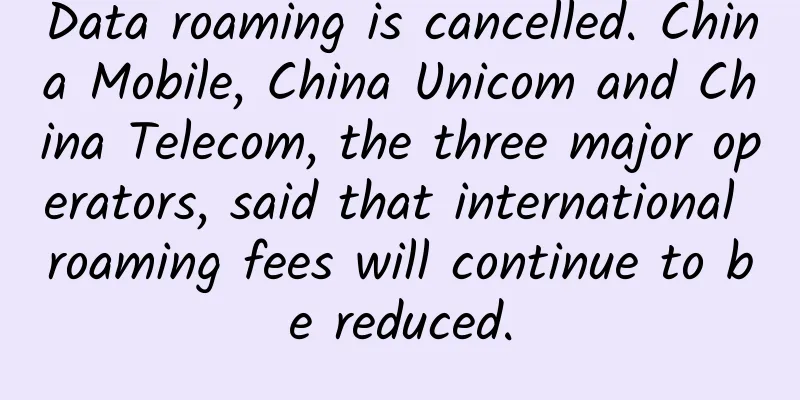Operators' mid-term performance is impressive, and 5G development has entered a critical moment

|
2021 is a big year for China's 5G development. Both base station construction and terminal popularization have become important milestones. With the release of a series of important mid-year summary data, we can understand the progress of the 5G industry.
5G network terminal applications are being fully promoted, and the industry value chain is maturingAccording to the financial reports released by the three major operators, they achieved the best performance in recent years in the first half of 2021, and also brought good user development. In the first half of 2021, China Telecom achieved operating revenue of 219.2 billion yuan, a year-on-year increase of 13.1%, and net profit attributable to the parent company of 17.7 billion yuan, a year-on-year increase of 27.2%; China Mobile achieved operating revenue of 443.6 billion yuan, a year-on-year increase of 13.8%, of which communication service revenue was 393.2 billion yuan, a year-on-year increase of 9.8%, and the company's net profit was 59.18 billion yuan, a year-on-year increase of 6%; China Unicom's operating income reached 164.2 billion yuan, a year-on-year increase of 9.2%. The total profit in the first half of the year exceeded 10 billion for the first time in recent years, and the growth rate of net profit attributable to the parent company increased by 9.8% compared with the full year of 2020. Data from China Mobile showed that the total number of users reached 947.465 million in July, of which 4G users increased by 6.602 million, totaling 805.45 million, and 5G package users increased by 28.913 million, totaling 279.608 million. China Telecom's operating data showed that in July, the number of China Telecom's mobile users increased by 2.13 million, with a total of 364.62 million mobile users. In the same month, the number of 5G package users increased by 7.06 million, with a total of 138.21 million 5G package users. In July, China Unicom added 1.155 million mobile account users, totaling 311.611 million. Among them, 5G users increased by 7.742 million in the month, totaling 121.072 million. According to the economic operation of my country's communications industry from January to July 2021 announced by the Ministry of Industry and Information Technology, as of the end of July, the total number of mobile phone users of the three major basic telecommunications companies reached 1.619 billion, a net increase of 25.21 million from the end of last year. Among them, the number of 5G mobile terminal connections reached 392 million, a net increase of 193 million from the end of last year. If we simply add them up, the total number of 5G users of the three major operators has reached 538 million, which accounts for about 1/3 of the total number of mobile phone users in China. Due to different statistical calibers, the actual number of mobile phone users who are already using 5G networks is probably still some distance away from this figure. However, even if calculated based on the number of 392 million 5G mobile terminal connections, it has reached 1/4, reflecting the rapid development of 5G mobile phone business. According to the data from the China Academy of Information and Communications Technology, the sales volume of 5G mobile phones in the Chinese market in July was 22.834 million units. From January to July this year, the shipment volume of 5G mobile phones in my country was 151 million units, a year-on-year increase of 94.3%, accounting for 74.3% of the mobile phone shipments in the same period. As of the end of July, the cumulative shipment volume of 5G mobile phones in the domestic market reached 327 million units. As of the end of July, the three major basic telecommunications companies had developed 1.306 billion cellular Internet of Things terminal users, a net increase of 170 million from the end of last year. Among them, terminal users used in smart manufacturing, smart transportation, and smart public utilities accounted for 17.5%, 17%, and 22.7% respectively. The number of smart public utilities terminal users increased by 26.7% year-on-year, with the most prominent growth. Data shows that from January to July, the cumulative mobile Internet traffic reached 122.8 billion GB, a year-on-year increase of 38.1%, and the growth rate increased by 4% year-on-year. Among them, the traffic through mobile Internet reached 117.6 billion GB, a year-on-year increase of 36.9%, accounting for 95.8% of the total mobile Internet traffic. In July, the average mobile Internet access traffic per household (DOU) reached 14.07GB/household/month, a year-on-year increase of 29.2%, and an increase of 2.15GB/household/month compared with the end of last year. The shipment volume of 5G mobile phones almost doubled year-on-year, the proportion of 5G mobile phones continued to increase, the ratio of 5G package users to the number of mobile terminal connections continued to increase, the number of terminal users in the Internet of Things industry increased significantly, and mobile Internet traffic continued to grow rapidly. All signs indicate that the actual usage rate of 5G is increasing, the 5G industry is maturing, and the value of the 5G industry is at a critical point of explosion. 5G development requires innovation and win-win cooperationIn the future, with the reduction of traffic charges and the enrichment of 5G applications, the digital transformation of enterprises and the new "stay-at-home" lifestyle are expected to further push up the demand for 5G applications. High-traffic application scenarios such as short videos, live broadcasts, online education, and online meetings are becoming mainstream applications for user consumption. With the continuous expansion of application scenarios such as smart mines, smart factories, and unmanned driving, "5G+Industrial Internet" is transforming from "model room" to "commercial housing", and the development of the industry is entering an acceleration period. In this context, operators should continue to promote 5G terminal sales, increase the conversion of 5G package users to actual use, and at the same time, vigorously promote 5G industry applications and increase the driving force of 5G business. Of course, operators have also made efforts. China Mobile's cloud computing business has grown exponentially; China Telecom's industrial digital business revenue reached 50.1 billion yuan, a year-on-year increase of 16.8%. 5G applications in the government and enterprise fields are gradually entering the harvest period, and 5G application scenarios have nearly doubled compared to the end of 2020. The real value of 5G lies in supporting the high-quality development of the real economy, and it urgently needs to be integrated with the real economy for application innovation. In this process, operators should always adhere to the 5G development strategy of win-win cooperation and implement it in specific actions, rather than competing with each other or undermining each other. It is generally believed that the development of 5G business will first bear fruit in industry applications, which has also become a new business growth point and major source of performance for operators. Therefore, several operators have begun to charge forward with all their strength. Given the historical inertia of several operators, when developing government and enterprise business, they are bound to sabotage each other and undercut each other on price, until the entire "blue ocean" is quickly turned into a "red ocean", while the operators' reputation continues to decline in the industry. But since the birth of 5G, several operators have embarked on a different path of cooperative development. For example, they simultaneously announced the launch of commercial use and cooperated to launch 5G messages... This is a good start. What needs to be done next is to truly achieve harmonious coexistence on the market sales and customer service ends. China Telecom and China Unicom have jointly built and shared in many aspects and achieved good economic benefits. They are comparable to China Mobile in terms of 5G network construction speed and scale, which has also promoted the healthy development of China's 5G industry. Through the joint construction and sharing of 700MHz spectrum resources, China Mobile and China Broadcasting Corporation are expected to enable users in rural areas to use cheap and easy-to-use 5G networks in the shortest possible time. At the same time, it will help China become the first in the world to build the largest and best-covered 5G industry foundation, which will promote the birth and development of a large number of 5G applications. Therefore, several operators should continue to follow the thinking mode of the shared economy, further introduce the successful business model and experience of the Internet platform over the years, and explore a 5G Internet of Everything industry path suitable for the development of operators. |
<<: In addition to 404, what other "codes" are there for web pages?
>>: This article explains in detail the discovery and processing of BigKey and HotKey in Redis
Recommend
What is the relationship between the Internet of Things and the Internet, when will the explosion occur and what are their uses?
Name Explanation The Internet of Things is an imp...
spinservers: 10Gbps high-end San Jose server, $109/month, dual E5 2650Lv3/64GB/1.6T SSD hard drive
spinservers is a site under Majestic Hosting Solu...
Data center "cloudification" solves the embarrassment of virtualization
Virtualization technology is being used more and ...
5G Thinking | Moderately Advance 5G Network Construction
Network construction is the cornerstone of 5G com...
RAKsmart: US CN2 line VPS monthly payment starts from $0.99, Japan/Hong Kong VPS monthly payment starts from $2.99
The day before yesterday, we shared the news of R...
Empowering dream makers in the intelligent era: the breakthrough and establishment of Huawei’s terminal distributed technology
[51CTO.com original article] Many people compare ...
Ministry of Industry and Information Technology: The information and communication industry is operating smoothly, with 5G users accounting for more than 30%
On November 21, the Ministry of Industry and Info...
[11.11] HostingViet: Vietnam VPS annual payment 40% off, 2GB/20G SSD/unlimited traffic/annual payment starting from 193 yuan
HostingViet also launched a Double 11 event. From...
HostYun: Los Angeles CN2 GIA line cheap version online, 1GB memory package monthly payment starts at 15 yuan
HostYun recently launched a low-cost package for ...
Comprehensive analysis of SEO optimization: From HTML tags to Sitemap.xml, the techniques you must know
In the digital age, acquiring website traffic dep...
Ftpit: $3.49/month KVM-1GB/20GB/1TB/3 data centers in Fremont, Los Angeles, and New York
Ftpit is a foreign hosting company founded in 201...
China Mobile Xiongyan Consulting Insights: 5G URLLC Key Technology Research Report
Labs Guide URLLC "Low Latency High Reliabili...
Recommend an operation and maintenance tool: a tool for collecting AD domain environment information
Project Introduction ADRecon extracts and consoli...
There is a 1024-bit bug. The TCP data packets are so annoying!
1. Background Recently, I encountered a particula...
Across four districts in Beijing, we tested whether the "network speed reduction" is true
Recently, a piece of news about the slowdown of d...









